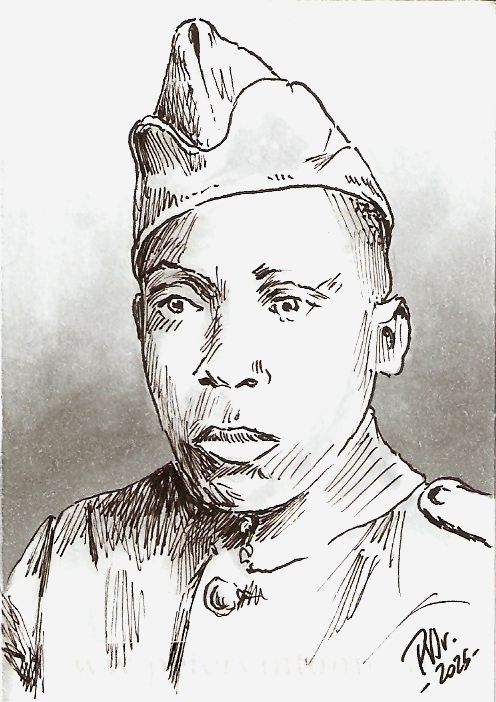An ongoing illustrative history study
This piece originally posted on 05/26/2025
(Memorial Day)
Prelude | 185 | 186 | 187 | 188 | 189 | 190 | 191 | 192 | 193 | Email |
|---|
![]()
 "One of the five bravest American soldiers in the war."
"One of the five bravest American soldiers in the war."
--Theodore Roosevelt, Jr.
This Decoration Day/Memorial Day we remember the heroic career of U.S. Army Sergeant (William) Henry Johnson. This particular trading card will be the last (for now) of my series-within-a-series of "mysteriously" absent biographies that aren't showing up on .mil and .gov websites anymore.
Born in 1892 North Carolina, Henry Johnson moved to Albany, New York and worked a number of jobs --including as a redcap porter at Union Station -- before enlisting in 1917. Signing on with the famed all-Black 369th Infantry ("Harlem Hellfighters," previously covered in Lessons #36, #60, #143, and #151 of this series); Johnson saw front-line action almost immediately in 1918.
At the time the 369th was brigaded with a French army colonial unit in the Champagne region, along the notorious western front. On the night of May 15, 1918, Pvt. Johnson and fellow Pvt. Needham Roberts were attacked in the Argonne forest by a German raiding party of approximately 12 soldiers. Roberts was wounded and very nearly made prisoner, but Johnson fought back in close-quartered combat with a French bolo knife, killing four of the enemy and managing to get Roberts to safety, though sustaining many wounds himself.
In the aftermath of his heroic actions, France awarded Johnson and Roberts the Croix de guerre with star and bronze palm; making them the first-ever American soldiers in World War I to receive such an honor. Pvt. Johnson's valor was even publicly praised by Gen. Pershing in an article in The Saturday Evening Post, and he was discharged in 1919 at the rank of Sergeant, complete with a victory parade in New York City. Unfortunately Johnson's notoriety would be of little use to him upon his return to civilian life; due to his wounds he was unable to return to work, even to his old porter job. For a time Johnson conducted a brief series of lecture tours but these soon became unpopular as he was unwilling to stick to many of the established fictions (such as the notion that white and Black American soldiers harmoniously fought side-by-side in the trenches), and he died in relative obscurity in 1929... though he is buried in Arlington National Cemetery.
On June 2, 2015, Johnson was posthumously awarded the Medal of Honor by President Barack Obama. On June 5, 2023, the former Fort Polk in Leesville, Louisiana was formally renamed to Fort Johnson in his honor.
(A glimmer of encouragement this Memorial Day --mind you, it is only the merest glimmer): the army.mil biographical page about Sgt. Johnson, at least as of this month, includes a prominent banner that reads: "We have deliberately taken some of our webpages offline in order to comply with Executive Orders and OSD Policy. The intent is to preserve our history, and we are working to re-publish content as soon as possible." While this is still a far cry from undoing actual censorship of Black history, it is at least a tacit acknowledgement from the U.S. Army's policymakers that there are some problematic regulations currently getting in the way of an honest historical reckoning. Whether or not anything more decisive is to happen in the coming months, is of course still an unknown. But when I pair this development along with this week's announcement that the U.S. Naval Academy library has restored most of the 400+ books that had been yanked from its shelves because of "DEI," there is cause for minuscule amounts of optimism.
Heaven knows it is certainly a far more appropriate --and respectful-- way of honoring U.S. military service than staging an expensive Third World dictator-style military parade through the streets of Washington, D.C.)
See you all in a few more days for Pride Month (and coincidentally entering the fifth year of this project).
Next lesson - Lesson 190: Alicia Garza